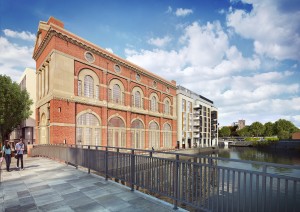Plans to develop office space for Bristol’s burgeoning tech, creative and media sectors in one of the city’s most iconic former industrial buildings have been given the go-ahead.
The Generator Building, with its characteristic red brick and stone façade overlooking the Floating Harbour, originally housed the generator for the Bristol’s tram system. 
Plans to give it a new lease of life were drawn up by Cubex, the Bristol-based developer behind the Finzels Reach mixed use scheme, and its funding partner Palmer Capital. Bristol City Council recently gave the scheme planning permission.
The firm believes there is a major gap in the market for an inspiring and unconventional working environment.
The Generator Building is the latest phase of high quality Grade A office development at Finzels Reach, which is also home to Aurora, a major speculative scheme that completes this summer and is now almost fully pre-let, and Bridgewater House.
Cubex director Peter Walford said: “It is fantastic to have received planning consent for this exciting project to give a new lease of life to one of Bristol’s landmark buildings. With a rich history linking the building to 20th century transport innovation, it will offer something truly unique to the office market at a time when demand for workspace for the burgeoning tech, creative and media sectors is high.”
Designed to make the most of the views across the harbour, the space will include 30,611 sq ft of offices over six floors, for up to 300 people. Interior finishes, including exposed feature brickwork, will complement the fabric of the building. Shower facilities will be provided on each level, and secure cycle storage and lockers, as well as 10 basement car parking spaces will be created.
Extensive renovations will be carried out to Generator Building, with repairs to the limestone ashlar stonework and dramatic windows, to bring the exterior back to its former glory.
The original 1890s arched front entrance on Counterslip with its grand Venetian window will be re-instated with new glass doors at street level. These will open into a triple-height foyer space beyond, allowing people to enjoy the original scale of the internal spaces for the first time in 30 years.
Bristol was the first city in Britain to build an electric tram service and the Generator Building was opened in 1899 to supply power to the massively expanding tramways network. The architect William Curtis Green later became better known for designing buildings such as Scotland Yard and the Dorchester Hotel in Park Lane. The Bristol power station contained four steam engines coupled to four generators and supplied power to the tramway system until 1941, when a bomb hit St Philips Bridge and cut the power cables.
Bristol architecture practice the Bush Consultancy has designed the new office conversion of the Generator Building and has also been responsible for the new design of the apartments in Cask Store, Georges Wharf and Hawkins Lane as well as Castle Bridge at Finzels Reach.






























